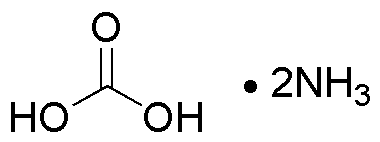Ammonium carbonate is widely utilized in research focused on:
- Baking Industry: It serves as a leavening agent in baking, helping dough rise and creating a light texture in products like cookies and cakes.
- Pharmaceuticals: This compound is used in the formulation of certain medications, particularly as a buffering agent to maintain pH levels, enhancing drug stability and effectiveness.
- Textile Industry: Ammonium carbonate is employed in the textile sector for fabric finishing processes, improving the softness and overall quality of materials.
- Cleaning Products: It acts as a mild abrasive and deodorizer in various cleaning formulations, making it effective for household and industrial cleaning applications.
- Laboratory Applications: In research settings, it is utilized as a reagent in various chemical reactions and as a source of ammonia in synthesis processes.
General Information
Properties
Safety and Regulations
Applications
Ammonium carbonate is widely utilized in research focused on:
- Baking Industry: It serves as a leavening agent in baking, helping dough rise and creating a light texture in products like cookies and cakes.
- Pharmaceuticals: This compound is used in the formulation of certain medications, particularly as a buffering agent to maintain pH levels, enhancing drug stability and effectiveness.
- Textile Industry: Ammonium carbonate is employed in the textile sector for fabric finishing processes, improving the softness and overall quality of materials.
- Cleaning Products: It acts as a mild abrasive and deodorizer in various cleaning formulations, making it effective for household and industrial cleaning applications.
- Laboratory Applications: In research settings, it is utilized as a reagent in various chemical reactions and as a source of ammonia in synthesis processes.
Documents
Safety Data Sheets (SDS)
The SDS provides comprehensive safety information on handling, storage, and disposal of the product.
Product Specification (PS)
The PS provides a comprehensive breakdown of the product’s properties, including chemical composition, physical state, purity, and storage requirements. It also details acceptable quality ranges and the product's intended applications.
Certificates of Analysis (COA)
Search for Certificates of Analysis (COA) by entering the products Lot Number. Lot and Batch Numbers can be found on a product’s label following the words ‘Lot’ or ‘Batch’.
*Catalog Number
*Lot Number
Certificates Of Origin (COO)
This COO confirms the country where the product was manufactured, and also details the materials and components used in it and whether it is derived from natural, synthetic, or other specific sources. This certificate may be required for customs, trade, and regulatory compliance.
*Catalog Number
*Lot Number
Safety Data Sheets (SDS)
The SDS provides comprehensive safety information on handling, storage, and disposal of the product.
DownloadProduct Specification (PS)
The PS provides a comprehensive breakdown of the product’s properties, including chemical composition, physical state, purity, and storage requirements. It also details acceptable quality ranges and the product's intended applications.
DownloadCertificates of Analysis (COA)
Search for Certificates of Analysis (COA) by entering the products Lot Number. Lot and Batch Numbers can be found on a product’s label following the words ‘Lot’ or ‘Batch’.
*Catalog Number
*Lot Number
Certificates Of Origin (COO)
This COO confirms the country where the product was manufactured, and also details the materials and components used in it and whether it is derived from natural, synthetic, or other specific sources. This certificate may be required for customs, trade, and regulatory compliance.

